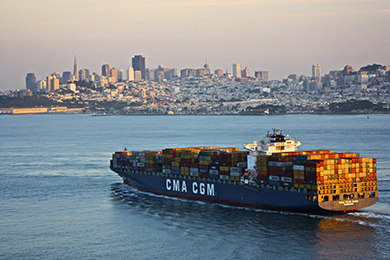| << Chapter < Page | Chapter >> Page > |
The question of how to organize economic institutions is typically not a black-or-white choice between all market or all government, but instead involves a balancing act over the appropriate combination of market freedom and government rules.

Recent decades have seen a trend toward globalization , which is the expanding cultural, political, and economic connections between people around the world. One measure of this is the increased buying and selling of goods, services, and assets across national borders—in other words, international trade and financial capital flows.
Globalization has occurred for a number of reasons. Improvements in shipping, as illustrated by the container ship shown in [link] , and air cargo have driven down transportation costs. Innovations in computing and telecommunications have made it easier and cheaper to manage long-distance economic connections of production and sales. Many valuable products and services in the modern economy can take the form of information—for example: computer software; financial advice; travel planning; music, books and movies; and blueprints for designing a building. These products and many others can be transported over telephones and computer networks at ever-lower costs. Finally, international agreements and treaties between countries have encouraged greater trade.
[link] presents one measure of globalization. It shows the percentage of domestic economic production that was exported for a selection of countries from 2010 to 2013, according to an entity known as The World Bank. Exports are the goods and services that are produced domestically and sold abroad. Imports are the goods and services that are produced abroad and then sold domestically. The size of total production in an economy is measured by the gross domestic product (GDP) . Thus, the ratio of exports divided by GDP measures what share of a country’s total economic production is sold in other countries.
| Country | 2010 | 2011 | 2012 | 2013 |
|---|---|---|---|---|
| Higher Income Countries | ||||
| United States | 12.4 | 13.6 | 13.6 | 13.5 |
| Belgium | 76.2 | 81.4 | 82.2 | 82.8 |
| Canada | 29.1 | 30.7 | 30.0 | 30.1 |
| France | 26.0 | 27.8 | 28.1 | 28.3 |
| Middle Income Countries | ||||
| Brazil | 10.9 | 11.9 | 12.6 | 12.6 |
| Mexico | 29.9 | 31.2 | 32.6 | 31.7 |
| South Korea | 49.4 | 55.7 | 56.3 | 53.9 |
| Lower Income Countries | ||||
| Chad | 36.8 | 38.9 | 36.9 | 32.2 |
| China | 29.4 | 28.5 | 27.3 | 26.4 |
| India | 22.0 | 23.9 | 24.0 | 24.8 |
| Nigeria | 25.3 | 31.3 | 31.4 | 18.0 |
In recent decades, the export/GDP ratio has generally risen, both worldwide and for the U.S. economy. Interestingly, the share of U.S. exports in proportion to the U.S. economy is well below the global average, in part because large economies like the United States can contain more of the division of labor inside their national borders. However, smaller economies like Belgium, Korea, and Canada need to trade across their borders with other countries to take full advantage of division of labor, specialization, and economies of scale. In this sense, the enormous U.S. economy is less affected by globalization than most other countries.

Notification Switch
Would you like to follow the 'Principles of economics' conversation and receive update notifications?